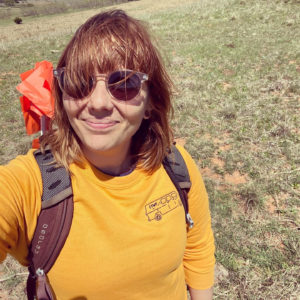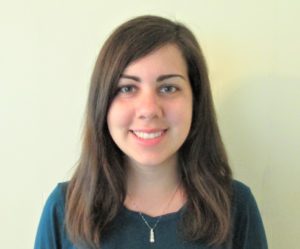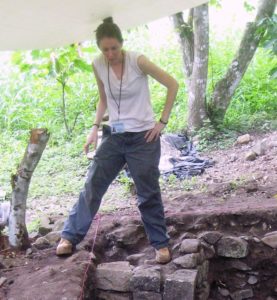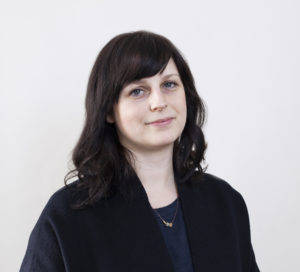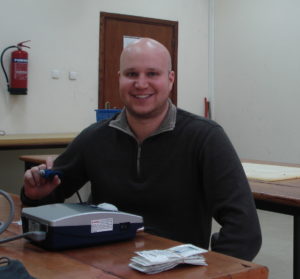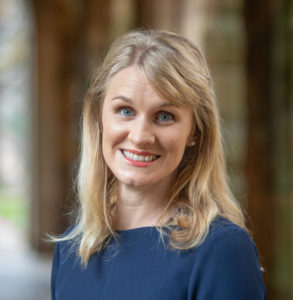Meet Our SAROI Fellows!
Our SAROI Fellows represent the many applications of spatial archaeology around the world that can enhance humanities-oriented inquiries.
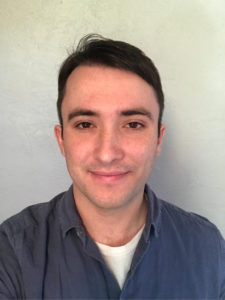
Wolfgang Alders, University of California-Berkeley and University of Arkansas, 2022-2023
Dr. Wolfgang Alders focuses on the archaeology of social transformation on the Swahili coast of East Africa, from the beginnings of urbanism to the development of plantation systems in the 19th century. After completing his PhD in Anthropology at the University of California Berkeley, he accepted at National Science Foundation postdoctoral research fellowship that is based at the University of Arkansas. Alders’ project with SAROI uses image classification methods with drone and satellite imagery to map baobab trees across the island of Zanzibar, Tanzania. Baobab trees have deep significance in coastal East Africa and can live for hundreds of years. Their cultivation in Zanzibar may correlate with specific settlement forms related to subsistence and adaptation in marginal environmental areas. Mapping baobab distributions on Zanzibar is one step in a larger project of predictive modeling, site detection, and survey across Zanzibar. This project aims to understand episodes of social reorganization on the island, like emergent urbanism, colonialism, and the economic and political transformations of the 19th century.
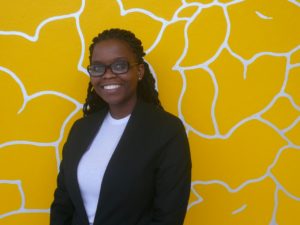
Stella Basinyi, University of Cape Town, 2022-2023
Dr. Stella Basinyi is a Post-Doctoral Research Fellow and an Advancing Womxn Fellow at the University of Cape Town, Department of Archaeology and Human Evolution Research Institution (HERI). She obtained a BA degree in Archaeology at the University of Botswana and worked at the Botswana National Museum before her Master of Arts studies in Culture and Environment in Africa at the University of Cologne and Doctoral studies at Justus Liebig University (Giessen, Germany) titled “Living with Heritage: The case of Tsodilo World heritage site and Neighbouring localities”. Her research work focuses on the heritage making process and illustrates the relevance of Archaeological cultural heritage and indigenous communities in the present. Her project uses 3D visualisation methods and Photogrammetry to map sensorial and visual representations of people and distinct spaces in Archaeological heritage sites in Botswana, Southern Africa . Her research interest includes historical and environmental archaeology, human-environment relations, localised cultures, heritage management and Rock Art Studies.
Brandi Bethke, Oklahoma Archaeological Survey, 2021-2022
Dr. Brandi Bethke serves as Laboratory Director and Research Faculty at the Oklahoma Archeological Survey, University of Oklahoma. Her research focuses on interactions between humans, animals, and the landscape in the North American Plains from the late precontact period to the present day through the integration of zooarchaeology, ethnohistory, geospatial analysis, and theory and methods derived from Collaborative Indigenous Archaeology. She is especially interested in the responses of Native American communities to European contact and the long-term consequences of settler colonialism. Her SAROI fellowship project was developed collaboratively with the Wichita and Affiliated Tribes and will utilize a combination of ethnography, archival research, and low-impact archaeological recording methods (non-collection survey, 3D-modeling and photogrammetry, geospatial mapping, geophysics, and small, targeted excavations) to record late nineteenth and early twentieth century farmsteads, camps, and dance grounds on allotted lands near Anadarko, Oklahoma. These places were and continue to be significant to the community and are critical for documenting how the Wichita people countered land-based assimilation efforts through the maintenance, creation, and adaption of their own community gathering spaces during the Allotment period.
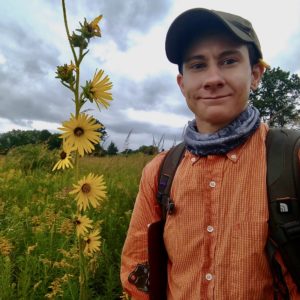
B Charles, University of Wisconsin Milwaukee, 2022-2023
Dr. B Charles is a bioarchaeologist and Postdoctoral Researcher at the University of Wisconsin Milwaukee. Their research focuses on nonadults at the historic-period Milwaukee County Poor Farm Cemetery (Wauwatosa, Wisconsin). B’s work contributes to the ongoing identification of individuals recovered from unnamed graves in effort to humanize those buried there and reassociate the dead with surviving kin. They are interested in pre- and postnatal skeletal growth and development with relation to maternal health, and they apply biocultural approaches to investigate gender and the medicalization of childbirth at the turn of the 20th century. As a SAROI fellow, B will cultivate skills in micro-computed tomography (microCT) to investigate the microstructures of infant long bones and differentiate healthy new bone growth from pathological, reactive growth. This non-destructive assessment will aid in identifying periods of metabolic stress during pregnancy and underlying maternal conditions that contribute to perinatal and infant mortality.
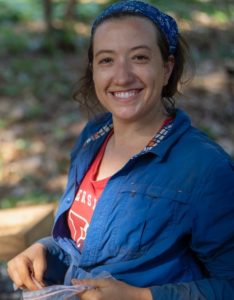
Elizabeth Clay, Central Connecticut State University, 2022-2023
Dr. Elizabeth Clay is an anthropological archaeologist specializing in the African Diaspora. She received her PhD in December 2021 from the University of Pennsylvania with a concentration in historical archaeology. Elizabeth’s research interests broadly include the materiality of colonial plantation societies in the Caribbean and South America, cultural heritage projects related to the legacies of enslavement, and digital curation of archaeological materials. Her most recent work explored 19th c. slavery and post-emancipation labor at a former spice plantation in French Guiana using geospatial, archival, and archaeological data alongside community-engaged plantation tourism. As a SAROI fellow, Elizabeth will be applying high-resolution landscape scanning to clarify the organization of domestic quarters, yards, and gardens of enslaved people at several 19th-c. plantation sites in one region of French Guiana, where these features remain obscured under heavy rainforest cover. This research explores the spatial formation of community by interrogating how the built environment intersects with power and identity, past and present. Revealing plantation landscapes in this context furthermore contributes to building Afro-Guianese cultural heritage projects that reckon with the legacies of past injustice.
Kaitlyn Davis, University of Colorado-Boulder and United States Forest Service, 2021-2022
Dr. Kaitlyn Davis is a Registered Professional Archaeologist and doctoral candidate in archaeology at the University of Colorado, Boulder. Kaitlyn is interested in interaction processes and changes in land use over time in the Pueblo Southwest. She earned her MA in anthropology (archaeology) from the University of Colorado and her BA in anthropology and environmental science from the University of Notre Dame. She also recently began an archaeology position with the US Forest Service in May 2021 and will start as an Assistant Professor at Northern Arizona University in Fall 2023. Her SAROI project is an extension of her dissertation research and involves collecting and using infrared data to assess the heat-retaining properties and continued utility of Ancestral Pueblo agricultural fields. As part of her efforts to make archaeological and geospatial data more accessible to stakeholders and the public, she also will be working on developing StoryMaps.
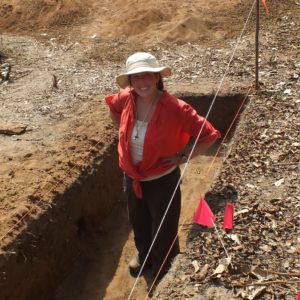 Kelly Goldberg, University of South Carolina, 2021-2022
Kelly Goldberg, University of South Carolina, 2021-2022
Dr. Kelly Goldberg is an Instructor of Anthropology for the Honors College at the University of South Carolina. As an anthropological archaeologist, she has worked at African Diaspora sites on both sides of the Atlantic. Engaging multidisciplinary approaches through a community archaeology framework, her research focuses on the role of transnationalism in the continuation of the transatlantic slave trade and the manifestation of contemporary memory and heritage politics at sites of threatened and contested heritage. As an SAROI Fellow, Kelly will further develop her public archaeology approach by receiving guided training and mentorship in the use of digital heritage and visualization methodologies, as well as aerial imagery and geophysical techniques. She will be able to incorporate these technologies in her current projects with the United States National Park Service, as well as in future initiatives in West Africa, to engage and incorporate a more diverse stakeholder group in archaeological research.
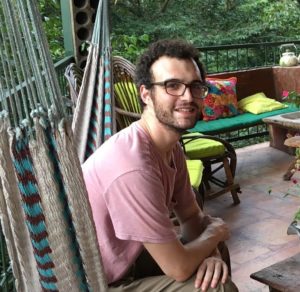 Graham Goodwin, University of California-Merced, 2021-2022
Graham Goodwin, University of California-Merced, 2021-2022
Graham Goodwin is currently a PhD student in the Interdisciplinary Humanities group at University of California-Merced studying under Nicola Lercari. His research interests focus on exploring sensory and bodily experiences in the past through digital methodologies such as Geographic Information Systems (GIS), Virtual Reality (VR), and 3D modeling supplemented by phenomenological description. He plans to use these digital methodologies such as airborne Light Detection and Ranging (LiDAR), digital photogrammetry, and Geographic Information Systems (GIS) to capture and analyze new geospatial datasets describing archaeological landscapes. His goal is to identify spatial patterns within urban spaces at the ancient Maya city of Palenque and examine whether and how these spatial relationships shaped a population’s experiences in antiquity. His methods to approach this question utilize different geospatial methodologies to analyze patterns of movement, visibility, and sound propagation so that the bodily experience of past people can be better understood. To achieve a more humanistic understanding of the past, phenomenological and embodied descriptions of sites, landscapes, and artifacts will be used to enhance objective and empirical digital methodologies.
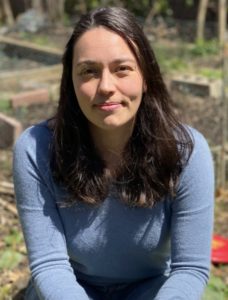
Julia Jong Haines, Cornell University and Syracuse University, 2022-2023
Dr. Julia Jong Haines is Mellon Postdoctoral Fellow at Cornell University and a historical archaeologist whose research focuses on the intersections of inequality, community identities, and landscapes. She is also an incoming faculty member at Syracuse University, starting Fall 2023. Her research examines the historical changes to the political economies of Asian and African diaspora communities on the Indian Ocean island Mauritius from the 18th through the mid-20th century—a time when the island was besieged by sugar cane monocropping, deforestation, and village/urban development. With local Mauritian collaborators, Dr. Haines is also involved in supporting community-centered heritage and public history projects. Her current research project asks: How did settlement emerge on the island, particularly in the spaces between sugar plantation borders? What inequities can we identify in the landscape due to communities’ local geographies and their access to resources? With the SAROI fellowship, Dr. Haines will integrate remote sensing landscape methods with her existing archival and archaeological data in order to model the long-term consequences of plantation systems on public health, social inequality, and ecological change that continued through and after the dissolution of slavery- and indenture-based economies on Mauritius.
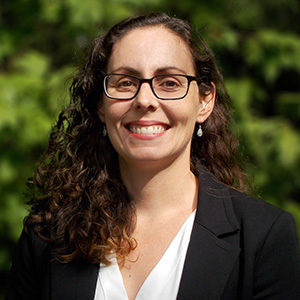
Jessica Kowalski, Arkansas Archaeological Survey, 2022-2023
Dr. Jessica Kowalski is a Research Station Archeologist for the Arkansas Archeological Survey in Fayetteville, Arkansas and a Research Assistant Professor in the Department of Anthropology at the University of Arkansas. Dr. Kowalski’s research interests include the organization of ancient complex societies, landscape archeology, the application of geographic information systems (GIS) to archeological problems, and the production, use, and distribution of Native American ceramics during the Mississippi period in the Southeastern United States (ca. AD 1050-1500). As part of her SAROI fellowship, she will use unmanned aerial vehicles (UAV) and thermography to locate archeological deposits in the Ozarks Highlands of Northwest Arkansas. Using a multi-scalar landscape approach, this project aims to document buried cultural deposits and the extent of constructed landscapes. As part of the Arkansas Archeological Survey’s mission to share what is learned about Arkansas history and culture heritage with the public, research on ancient landscape use in the Ozarks using digital technology will be published online at www.archeology.uark.edu.
Kristin Landau, Loyola University Chicago, 2021-2022
As an archaeologist, Dr. Kristin Landau have worked in collaboration with local communities in the ancient Maya area of western Honduras for 15 years. Specifically, Kristin is interested in how ancient people living in urban neighborhoods managed their day-to-day lives in response to citywide political and economic dynamics. As a SAROI Fellow, she will investigate the site of Los Sapos (The Toads), a unique ritual area with carved aquatic creatures located in the San Lucas neighborhood of the UNESCO World Heritage Site of Copán. Kristin will work with Indigenous youth and Honduran authorities to conduct the first 3D scan of Los Sapos using TLS/Photogrammetry, and create a publicly-accessible website of the resulting imagery.
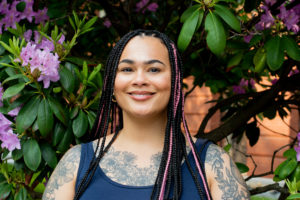
Aja Lans, Johns Hopkins University, 2022-2023
Dr. Aja Lans is an assistant professor in the Department of Anthropology and Center for Africana Studies at Johns Hopkins University. She completed her PhD in anthropology with a focus on bioarchaeology and cultural heritage preservation at Syracuse University. She integrates Black feminist and critical race theory into her bioarchaeological research, arguing for the repatriation of Black Ancestors curated in skeletal collections. Her SAROI project focuses on the Old Burying Ground located in Cambridge, Massachusetts. Opened in 1635, the burial ground contains the marked graves of two enslaved women, Jane (d. 1741) and Cicely (d. 1714). Both were buried on what was the periphery of the cemetery, far from their enslavers, and their status as “negro servants” is engraved on their markers. Aja is working with collaborators from Harvard University to map the cemetery, create digital records of the grave markers, and perform ground penetrating radar to locate unmarked burials that might potentially belong to other enslaved individuals. The project aims to highlight Harvard’s ties to slavery as well as argue against the myth of a supposed “gentler” form of slavery in New England.
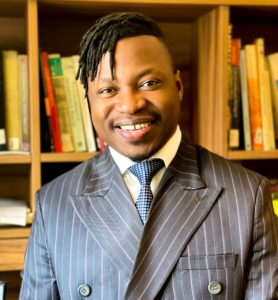
Olanrewaju Lasisi, William and Mary College and Dumbarton Oaks, Harvard University, 2022-2023
Olanrewaju Lasisi is a Ph.D. candidate in the Anthropology Department at William & Mary, and a Garden & Landscape Studies Junior Research Fellow at Dumbarton Oaks, Harvard University. His research examines how the practice of space mirrors the practice of power politics among the Ijebu-Yoruba of southwestern Nigeria. Specifically, he is interested in how the intersection of architecture, ritual, and astronomy manifests power and defines the Yoruba complex societies. As a SAROI Fellow, he will investigate how the indigenous Yoruba population practiced astronomy. He will use GIS tools to map alignments and orientations observed in ritual movements, potsherd pavements, and the built environment. He will also acquire the digital skills of extracting spatial information from LiDAR data on the Ijebu fortifications and its capital city to identify potential archaeological sites in the understudied Ijebu area. On a longitudinal research activity, Olanrewaju will acquire photogrammetry skills to digitally document and exhibit threatened archaeological and ethnographic art objects, some of which are presently housed at the Ijebu National Museum, Ijebu, Nigeria.
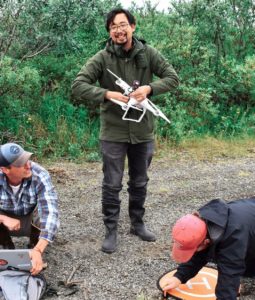
Jonathan Lim, University of Oxford, 2022-2023
Jonathan Lim is a DPhil candidate in Archaeology at the University of Oxford, and a member of the Space@Oxford research group. He works closely with the Alaska Native community of Quinhagak to co-create new ways of mapping their cultural landscape. In this effort, he makes use of ethnographic approaches alongside spatial technology—particularly the analysis of multispectral imagery from satellites and unpiloted aerial vehicles (UAV’s). As a SAROI fellow, Jonathan will expand on his knowledge of conducting UAV mounted-LiDAR surveys and processing the resulting point-cloud data; such technology is vital for characterizing Yup’ik historic landscapes in the Yukon-Kuskokwim Delta, and for monitoring climate change-related erosion. He will also work towards the creation of Python-based automated workflow scripts for carrying out landscape surveys in this region, a necessity for rapidly empowering local communities with additional tools to manage their cultural environment.
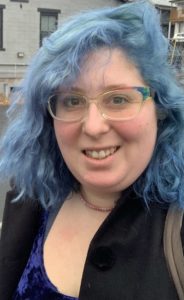
Jennifer Lupu, Northwestern University, 2022-2023
Jennifer Lupu is a PhD candidate at Northwestern University. Her research draws upon archaeological reports and archival statistics to map patterns in disease epidemics and access to medicine and healthcare in Washington, DC from 1860-1920. Bringing in discussions of environmental racism, the history of medicine and capitalism, urban lifeways, and queerness/gender nonconformity, her research provides historical context for topics relevant to present-day social issues in the United States. Her PhD dissertation analyzes materials from a racially and socio-economically varied sample of archaeologically excavated household trash deposits from across Washington, DC to analyze household use pattens of pharmaceutical bottles. As a period that includes the start of governmental regulation of medicine, rapid growth of the pharmaceutical industry, the beginning of urban sanitation and water filtration initiatives, alongside increasingly segregated cities and the passage of Jim Crow and Jim Crow-inspired laws, the turn of the century is a critical moment in which to view the impact of systemic changes that have continued to shape the landscape of American healthcare.
Brandi L. MacDonald, Missouri University Research Reactor and University of Missouri-Columbia, 2021-2022
Dr. Brandi MacDonald an Assistant Research Professor at the Archaeometry Lab at MURR, an Executive Officer at the Society for Archaeological Sciences, and a managing editor at the journal Archaeometry. Brandi’s expertise is in provenance studies and analytical chemistry in archaeological sciences, with a longstanding interest in rock art and mineral pigments. Her SAROI fellowship will enable me to get guided mentorship on 3D modeling and image processing for digital reconstructions of rock art and the landscapes/formations in which it is situated. This skill set will enhance an ongoing collaborative project on rock art documentation and pigment analysis with Lake Babine Nation (British Columbia, Canada), under the aegis of the Babine Archaeology Project with collaborator Dr. Farid Rahemtulla (U of Northern BC).
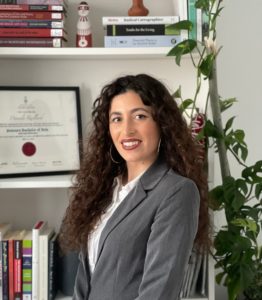
Daniela Raillard Arias, Northwestern University, 2022-2023
Daniela Maria Raillard Arias (MA) is a PhD candidate and archaeologist of the South American Andes at Northwestern University. Daniela’s dissertation research examines above-ground mortuary landscapes of the pre-colonial Chachapoya, between the Andes and Amazon of northeastern Peru. Specifically, she collaborates with local and descendant community members to conduct participatory mapping, aerial photogrammetry, geospatial analysis, and architectural survey of mausolea, sepulchers, and other above-ground funerary structures in vertical environments. This approach involves minimally invasive research practices that center local spatial knowledge, Indigenous Ecological Knowledge systems and community-based methods to investigate questions of ancestor agency and landscape. As a SAROI fellow, Daniela will train in aerial-mounted LiDAR, digital heritage, and other geospatial techniques to document mortuary architecture in limestone cliff faces, identify access patterns, and determine building technologies. Spatial datasets will be integrated into a heritage management plan in partnership with local rural tourism associations and cultural knowledge holders to mitigate degradation by looting, environmental conditions, and tourism development. Imagery will be made available to local and descendant communities as well as broader publics to curate a digital heritage for interactive experiences of Chachapoya landscapes. Learn more about Daniela’s work by visiting her website: www.danielaraillardarias.com.
Joshua Robinson, Boston University, 2021-2022
Dr. Josh Robinson is a paleoanthropologist and Paleolithic archaeologist interested in the paleoecology of Plio-Pleistocene migration and mixing corridors in eastern and southern Africa. Using quantitative paleoenvironmental methods, including stable isotope analysis of fossil faunal tooth enamel and paleosol carbonates, he studies the transition from the Middle to the Later Stone Age. This is a critical period of human evolution during which various populations of Homo sapiens, as well as other transitional or archaic hominins, exchanged genes, ideas, and technology. As a SAROI fellow, Josh’s aim is to create and leverage high-resolution ecological and terrain datasets in geospatial environments for investigating the potential for relationships and interactions of different populations on the landscape. By gaining insight into the where, when, and how of connections between different populations in the late Pleistocene, we can develop a deeper understanding of what it means to be human.
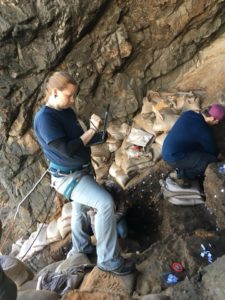
Sara Watson, University of California Davis and Field Museum Chicago, 2022-2023
Sara Watson is a recent PhD recipient in the Anthropology Department at the University of California, Davis and a new Postdoctoral Research at the Field Museum Chicago. She is an archaeologist and paleoanthropologist interested in behavioral changes within our species during the late Pleistocene in southern Africa, a period when we see the emergence of new technologies and an overall expansion of the material culture record relative to earlier periods. These changes have been argued to represent the development of increasingly complex technologies and some of the earliest evidence of behaviors that, later in time, are described as typical of our species. Sara’s SAORI project examines whether expansions of the material culture record observed during the late Pleistocene are the result of the gradual accumulation of new behaviors within modern humans or a decay curve produced by taphonomic processes. As a SAORI fellow, Sara will work with Geographic Information Systems (GIS) to investigate potential relationships between the presence of behavioral proxies in the archaeological record and their depositional context to understand the effects of preservation bias on early occurrences of artifacts that feature prominently in arguments of behavioral changes in modern humans. The results from this project have important implications for our understanding of the evolution of Homo sapiens and the origins of behaviors argued to be defining characteristics of modern humans.
Camille Westmont, University of the South, 2021-2022
Dr. Camille Westmont is currently the Postdoctoral Fellow in Historical Archaeology at the University of the South in Sewanee, Tennessee. She received her doctorate in anthropology with a specialization in historical archaeology in 2019 from the University of Maryland. She also holds a Masters of Historic Preservation. Camille’s research interests center around 18th, 19th, and 20th century industrial communities and industrial landscapes. While the majority of her work has been carried out in the context of the US coal mining industry, she has also worked on similar topics in Iceland, Sweden, and Jamaica. As a SAROI fellow, she will be exploring the ways that the design of industrial landscapes shape workers’ sense of self. Specifically, Dr. Westmont will be applying spatial techniques and analyses to the Lone Rock Stockade, a late 19th century private prison used to house primarily African American convict laborers as part of the American South’s postbellum convict leasing system. This work brings together scientific perspectives on landscapes with humanistic evaluations of control, race, identity, resistance, and movement in order to provide more holistic understandings of people’s relationships with the spaces with inhabit.
